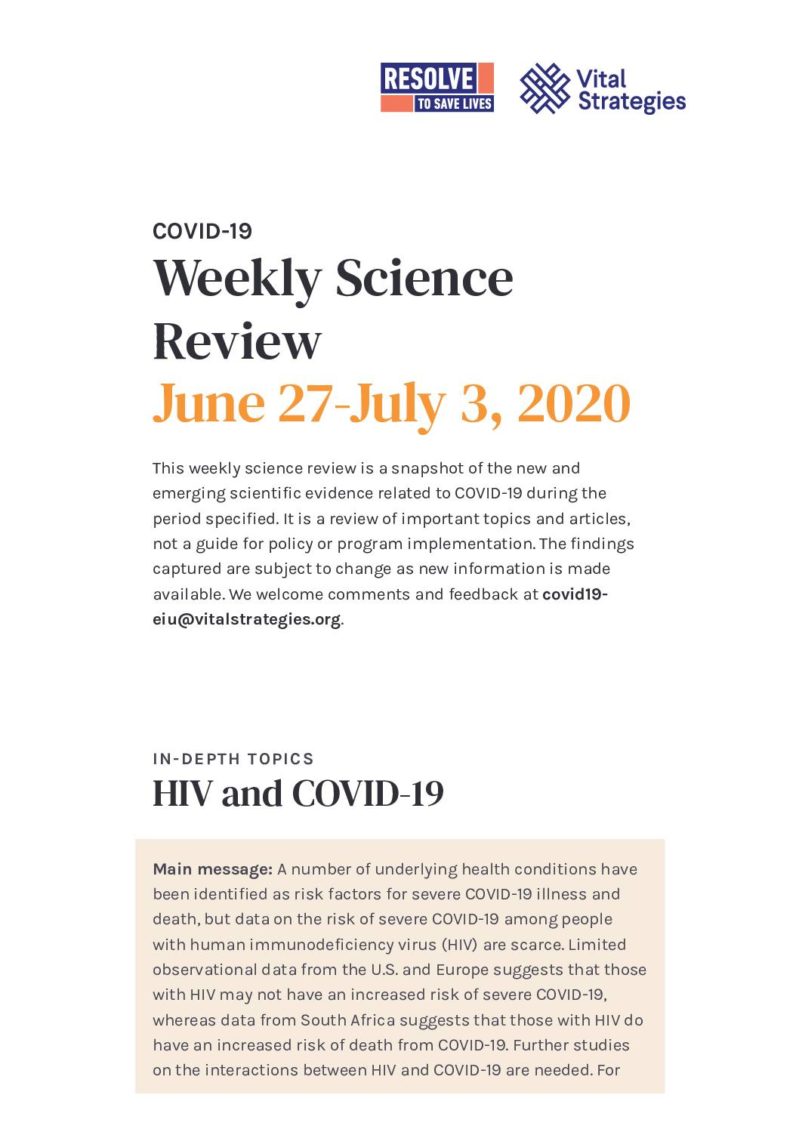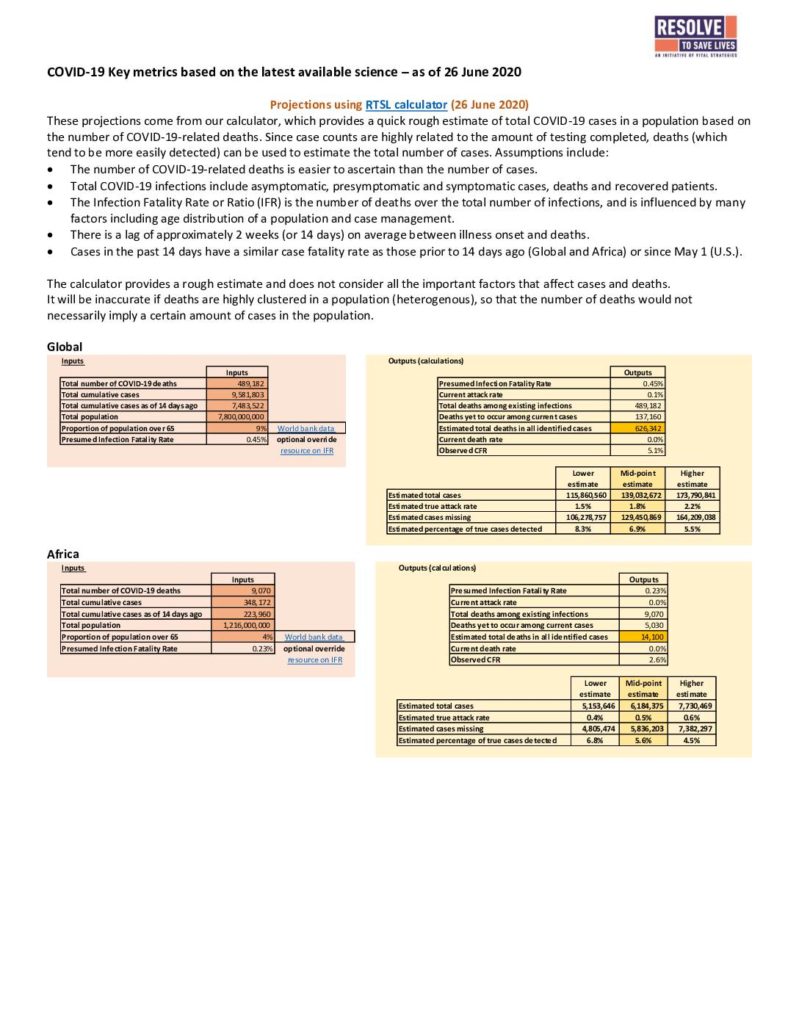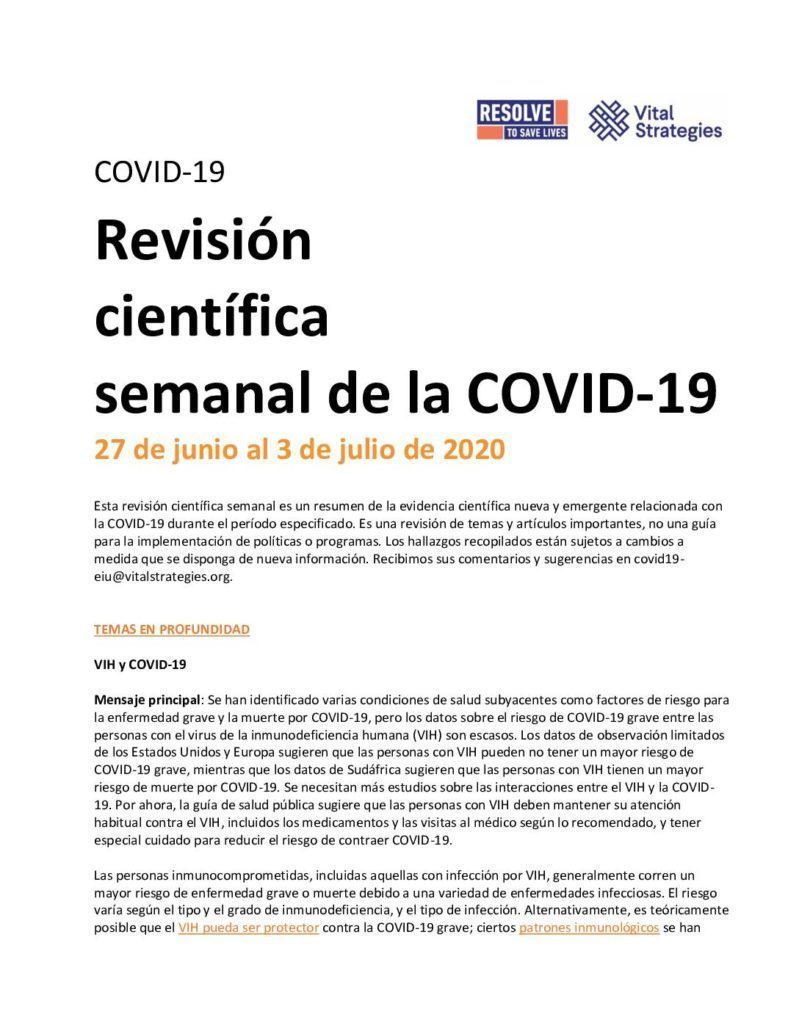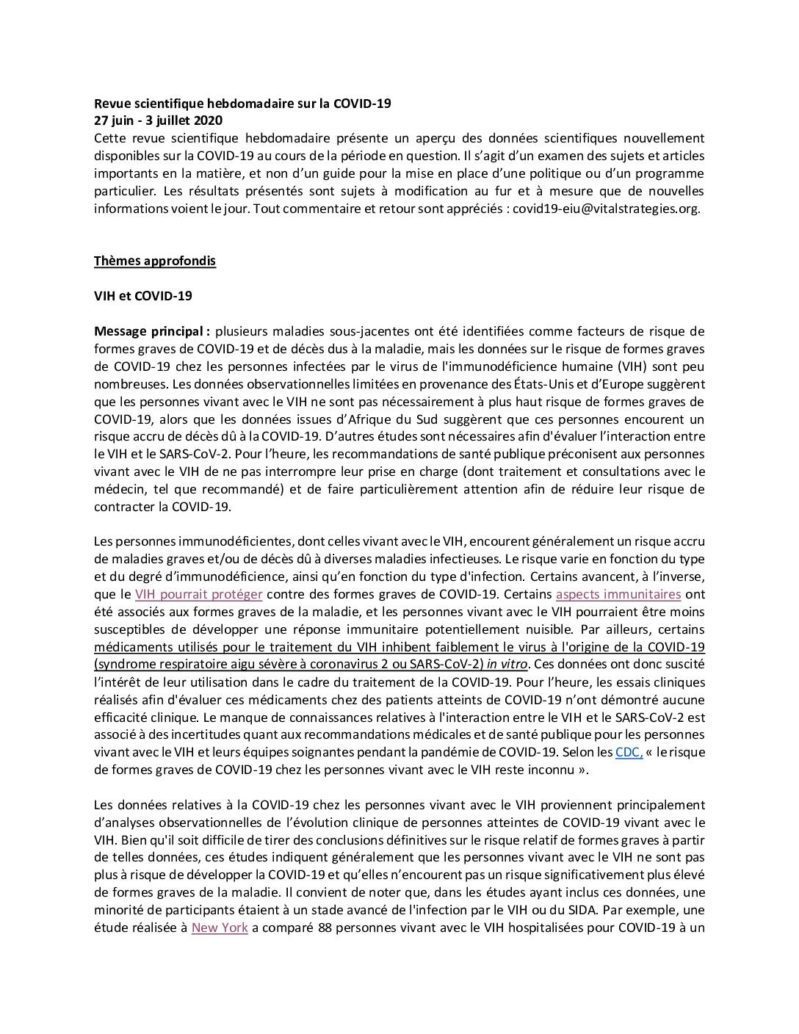In-depth topics
HIV and COVID-19
People who are immunocompromised, including those with HIV infection, are generally at increased risk of serious illness and/or death from a range of infectious diseases. The risk varies by type and degree of immunocompromise and by the type of infection. Alternatively, it is theoretically possible that HIV could be protective against severe COVID-19; certain immunologic patterns have been associated with severe COVID-19, and people with HIV may be less likely to have potentially harmful immunologic responses. In addition, some medications used to treat HIV weakly inhibit the virus that causes COVID-19 (severe acute respiratory syndrome coronavirus 2, or SARS-CoV-2) in vitro, which has generated interest in their use as COVID-19 treatment. Thus far, trials of these drugs to treat COVID-19 have not demonstrated clinical efficacy. Lack of knowledge about the interaction of HIV and COVID-19 has led to uncertainty about medical and public health guidance for people with HIV and their healthcare providers during the COVID-19 pandemic. According to the CDC, “the risk of serious illness from COVID-19 for people with HIV is not known.”
Data on COVID-19 among people with HIV has come largely from observational analyses of COVID-19 outcomes among people with and without HIV. Although it is difficult to draw definitive conclusions about relative risk of severe disease from such data, these studies have generally indicated that COVID-19 does not occur more frequently among people with HIV and that they are not at significantly increased risk of severe COVID-19. Of note, in the studies that included these data, a minority of participants had advanced HIV or AIDS. For example, a study from New York City, which compared 88 people with HIV hospitalized with COVID-19 to a demographically matched group of hospitalized COVID-19 patients without HIV, found no difference in COVID-19 severity upon admission to the hospital and a similar incidence of death between the two groups. In New Jersey, 27 people with HIV who were hospitalized with COVID-19 were observed to have similar clinical presentations to COVID-19 patients without HIV. In Spain, the incidence of COVID-19 among people with HIV was similar to the incidence of COVID-19 in the general population. Among people with HIV, those who developed COVID-19 had a higher prevalence of chronic comorbidities such as diabetes and kidney disease. People with HIV who had severe COVID-19 tended to have more advanced immunosuppression than those with mild COVID-19, but the difference was not significant. Of note, it can be difficult to tease apart the relative effects of HIV versus other medical conditions that are known to confer significantly increased risk of severe COVID-19, particularly when study sample sizes are small. Certain underlying medical conditions are more common among people with HIV in comparison with the general population; in a number of studies describing COVID-19 patients with underlying HIV, the prevalence of other comorbidities has been high. For example, in Germany, a higher rate of severe COVID-19 was observed among 33 people with HIV hospitalized with COVID-19 compared to the general population with COVID-19. Comorbidities were documented in a significant proportion of those with HIV, and the authors concluded that their data did not suggest excess COVID-19-related morbidity and mortality among people with HIV.
The first data from Africa on COVID-19 among people with HIV has recently been released from South Africa, a country with a high HIV prevalence that has been substantially affected by COVID-19. For this analysis, routine public health sector data on approximately 3.5 million adults from Western Cape Province were used to identify factors associated with death from COVID-19. There were 15,978 confirmed COVID-19 cases reported between March 1 and June 4, 2020. There were 97 deaths among approximately 520,000 people with HIV (187 COVID-19 deaths per million population) and 573 deaths among 6.4 million people without HIV (90 COVID-19 deaths per million population). Analyses showed that COVID-19 death was associated with male sex, increasing age, diabetes mellitus, hypertension, chronic kidney disease, and previous and current tuberculosis. After adjusting for these factors, there was an increased risk of COVID-19 death in people with HIV compared to those without HIV (adjusted hazard ratio [aHR] 2.75; 95% CI 2.09, 3.61). There was a more substantial increase in risk of COVID-19 death associated with advanced age and with several other comorbidities, and less than 10% of COVID-19 deaths were attributed to HIV. These data indicate that people with HIV may have a modestly increased risk of COVID-19 death compared with those without HIV. Further studies are needed to tease apart interactions between HIV and COVID-19, and these interactions may differ depending on the degree of immunosuppression and the epidemiologic context.
Colleges and universities confront COVID-19
In recent Weekly Science Reviews we have provided updates on returning to work and reopening primary and secondary schools. Institutions of higher education, including colleges and universities around the world, were also closed or hastily converted to remote learning earlier this year. With the coming start of the academic year in North America and many other places, institutions of higher education face many of the same challenges as worksites and primary and secondary schools as they contemplate how to reopen. Additional considerations for institutions of higher education include: addressing the high rate of interpersonal contact in classrooms, communal living and informal settings; maintaining and decontaminating numerous high traffic areas; protecting many older and medically vulnerable faculty and staff; and receiving students from diverse communities and transmission settings (including out-of-state and international students and faculty). College students, mostly young adults, are generally healthy and at lower risk of severe and fatal COVID-19 than older adults, but they are more likely to develop serious illness if infected with the virus that causes COVID-19 than school-aged children. In the United States, for example, the cumulative incidence of COVID-19 among 20-29 year olds through the end of May 2020 was 401.6 per 100,000—almost identical to the incidence across the total population. And in recent weeks cases among young adults have been rising. Furthermore, institutions of higher education convene a broad cross-section of students, staff and faculty including those with predisposing conditions and older adults at higher risk of severe COVID-19 illness. Outbreaks that begin or take hold among college and university staff and students can easily contribute to spread in the wider community, where many affiliated with the institutions of higher education live, work and socialize beyond the reach of administration policies.
As the new academic year approaches, administrators are forced to weigh their commitments to education and research against their responsibility for ensuring safety in the context of imperfect and rapidly changing information. Many are committed to some form of return to residential and in-person learning with modifications. Approaches can vary from school to school, and even nearby institutions may announce divergent courses of action. The Chronicle of Higher Education is tracking plans reported from 1,050 institutions of higher education in the United States: currently 61% plan to resume in-person classes, 8% will remain entirely online (including the entire California State University system), and 19% are proposing a blended learning model. Some have announced plans to convene the fall term earlier than usual, forego the mid-term break and dismiss students before the Thanksgiving holiday in late November, hoping to avoid an anticipated peak of COVID-19 transmission that could overlap with the expected influenza season during the winter months. In the United Kingdom, some university officials are considering creating “social bubbles” of students who will live and learn together. Even institutions of higher education that do opt to resume in-person education will need to accommodate learners, educators and staff who cannot or choose not to return.
The U.S. Centers for Disease Control and Prevention (CDC) notes that administrators can take steps to reduce the risk of COVID-19 exposure and spread at institutions of higher education. The lowest risk approach requires closing on-campus housing and conducting all classes, activities and events in virtual formats. Apart from that, measures that reduce class sizes and residential capacity will lead to less risk than a full return to former operations. CDC’s comprehensive resources for higher education communities emphasize promoting behaviors that reduce spread, maintaining healthy environments and healthy operations, and preparing for when someone gets ill. The guidance to these institutions also recommends screening, testing and contact tracing. As in other settings, viral testing is recommended for people with signs or symptoms consistent with COVID-19 or with recent known or suspected exposure to SARS-CoV-2, the virus that causes COVID-19.
Although it is not specifically recommended, some institutions of higher education plan to test all returning students, faculty and staff for COVID-19 before allowing them on campus (entry testing). It is unknown if entry testing will reduce transmission beyond what could be achieved with public health and social measures (e.g., physical distancing, face coverings, hand hygiene, enhanced cleaning and disinfection, staying home when ill), which should be optimized regardless of the testing approach. Entry or other screening testing regimens should not lead institutions to let down their guard, because it is highly likely that cases will be detected outside of any screening program, leading to potential on-campus exposures.
The COVID-19 pandemic has forced sweeping reconsideration of nearly every aspect of campus life—not just classes and residential accommodation, but admissions, athletics and study-abroad programs. For many college and university administrators the COVID-19 pandemic is an existential threat as well. Most are anticipating reduced enrollment and the loss of income generated through tuition and public funding. At the same time, their ability to mobilize funding from research and investments is likely to diminish as well. Some may not survive, and disparities between institutions are likely to grow. In many places the economic fate of institutions of higher education drives the prosperity of their surrounding communities. It is especially important that administrators comply with federal, state, and local health and safety regulations and coordinate their reopening plans, recognizing that the steps they take will have effects off-campus as well.
Weekly Research Highlights
Estimation of Excess Deaths Associated With the COVID-19 Pandemic in the United States, March to May 2020
(JAMA, July 1)
- State-specific data on deaths due to pneumonia, influenza, COVID-19 and all causes during 2020 and previous years was obtained from the National Center for Health Statistics (NCHS) mortality surveillance system. To calculate excess mortality, the authors estimated the baseline expected number of deaths without COVID-19 for the period from March 1 to May 30, 2020. They compared these estimates to official tallies of COVID-19-related mortality and influenza-like illness. Authors adjusted for yearly influenza virus circulation and they considered the number of tests performed per capita.
- From March 1 to May 30, 2020, there were 95,235 deaths officially attributed to COVID-19 in the United States. There were an estimated 122,300 (95% prediction interval, 116,800-127,000) excess deaths during the same period. Deaths officially attributed to COVID-19 accounted for 78% of excess mortality, leaving 22% unattributed to COVID-19. Some states (including Louisiana, Michigan, and New Jersey) had notable increases in all-cause mortality in 2020 while others (including Hawaii, Maine, and Montana) did not. The proportion of excess deaths that were unattributed to COVID-19 varied between states (for example: 41% in California and 12% in Minnesota). Some discrepancies between reported COVID-19 deaths and excess deaths may be related to testing intensity (in California, the increase in excess deaths preceded the increase in testing volume; in Minnesota, the increase in excess deaths coincided with the increase in testing volume). Increases in excess deaths in many states followed increases in reported influenza-like illness.
- The number of excess deaths in 2020 could be influenced indirectly by the pandemic (i.e. by delays in care seeking or by declines in deaths due to certain causes such as traffic accidents). Comparisons of influenza activity and influenza-like illness between 2020 and other years may be problematic; influenza activity declined to historically low levels in 2020, potentially related to reduction of transmission and/or to under-detection due to changes in healthcare seeking behavior.
Test Sensitivity is Secondary to Frequency and Turnaround Time for COVID-19 Surveillance
(medRxiv, preprint, June 22)
- In this unrefereed preprint, researchers simulated the impact of strategies for COVID-19 surveillance among asymptomatic people on the ability to detect outbreaks and control epidemic spread. The models allowed investigators to vary test accessibility, frequency, sensitivity and sample-to-answer time. Compared with no testing, surveillance among asymptomatic people could suppress the total number of infections when repeated daily or every three days and contributed to mitigating transmission at intervals of up to 14 days.
- The most sensitive COVID-19 test currently available (real time quantitative PCR) would remove more infections by detecting them up to a day earlier than less sensitive point-of care-tests (such as nucleic acid LAMP and rapid antigen tests). However, this potential advantage was off-set if less sensitive tests could be repeated at intervals of less than one week and provided results without delay.
- In modeled scenarios where surveillance testing of asymptomatic people was predicted to contribute to reduced transmission, it was insufficient unless public health and social measures such as physical distancing were also maintained. The authors conclude that surveillance testing of asymptomatic people may be a useful added tool to help limit the spread of SARS-CoV-2, the virus that causes COVID-19. Until this can be verified through real-world experience, surveillance testing of asymptomatic persons without a known exposure is not recommended beyond limited settings such as skilled nursing facilities.
- The models incorporated a range of transmission rates but did not include the potential impact of contact tracing in order to isolate the role of surveillance testing. In addition, some of the surveillance strategies examined in these models may subject a number of people to unnecessary isolation.
Exposures Before Issuance of Stay-at-Home Orders Among Persons with Laboratory-Confirmed COVID-19 — Colorado, March 2020
(MMWR, Early Release, June 30)
- Researchers in Colorado contacted 600 randomly selected people who were diagnosed with laboratory-confirmed COVID-19 between March 9 and March 26 in that state, and were able to recruit 364 to participate in their survey. They asked questions about known contacts with COVID-19 and places where exposure likely took place.
- Most people (73%) reported no known contact with COVID-19, although nearly one third of these people reported contact with someone who had symptoms that could be compatible with COVID-19. Others reported a high-risk activity within two weeks of diagnosis, such as attending a social gathering with more than 10 people or domestic travel. Of the 27% who had a known COVID-19 contact, the most commonly reported relationship to the contact was a family member or a coworker, and the most common exposure locations were in the workplace or in the household. Most (60%) of the coworkers were health care personnel.
- The results of this survey are subject to response bias, and the findings are likely not generalizable. Although the period of interest for COVID-19 diagnosis in this survey was prior to stay-at-home orders, other community mitigation measures were in place during this time.
Tracking Changes in SARS-CoV-2 Spike: Evidence that D614G Increases Infectivity of the COVID-19 Virus
(Cell, preprint, July 2)
- Researchers developed a bioinformatics pipeline to search for changes in SARS-CoV-2 genetic sequences. They identified a specific variant present in 10% of global isolates by March 1 and rising to account for nearly 80% by the end of May. This variation results in a single amino acid change in the spike protein, from aspartic acid to glycine (D614G), along with three other mutations. D614G has since become the dominant form of the virus worldwide—first in Europe, followed by North America and Oceania, then Asia—which suggests that it has a survival advantage over the original Wuhan form.
- Clinical data from 999 patients in the U.K. suggest that those infected with the D614G haplotype had more copies of viral RNA in upper respiratory test samples than patients without this form. There was no corresponding difference in the severity of illness, in contrast with an earlier observational study suggesting higher mortality in settings where D614G was predominant. In laboratory studies, pseudoviruses with the variant form (G614) also produced higher titers than those with the original form (D614).
- These clinical and laboratory findings could indicate that the D614G variant is more easily transmissible, one possible explanation for why it has replaced the earlier form nearly everywhere. Other factors that might contribute include sampling bias, founder effect from the D614G variant being introduced early in highly mobile and connected populations, and an effect of one of the other mutations that almost always accompany D614G.
Characteristics of Adult Outpatients and Inpatients with COVID-19 – 11 Academic Medical Centers, United States, March – May 2020
(MMWR, 3 July)
Main message: Researchers conducted and analyzed telephone surveys from 350 people recently diagnosed with COVID-19 to obtain additional information about their exposures during the two weeks prior to becoming ill or testing positive, as well as their symptoms when they sought care. More than half of the survey respondents did not have a known exposure to someone with COVID-19. For those that did have a known COVID-19 contact, the most common exposures were to a family member (45%), or to a coworker (34%). Most of the respondents who were working during the period before their illness were not able to telework. Those who were tested while hospitalized were more likely to report shortness of breath. The results from this study reinforce the need for safe workplaces, and for continued efforts to investigate cases, trace contacts and isolate infected persons to interrupt community transmission.
- Collaborators from 11 medical centers across the U.S. participated in conducting a telephone survey of people with lab-confirmed COVID-19 who were tested between March 31 and May 10, 2020. Of the 350 people who met criteria to participate, most were tested as outpatients (77%). The survey consisted of questions about baseline demographic characteristics, types of exposure in the two weeks prior to illness, and the symptoms each patient experienced.
- Inpatients were more likely to be older, non-White, have more than one underlying medical condition and to report shortness of breath as a symptom. Forty-six percent of survey respondents reported close contact with someone who had COVID-19 during the two weeks prior to their own illness. The most common close contact was a family member (45%), and the second most common was a coworker (34%). Only 17% of employed respondents said that they were able to telework.
- Limitations of this study include that they are not representative of the general population in the U.S. and subject to bias from those who were not able to respond to the telephone survey because they were still hospitalized or more severely ill. Respondents were also being asked to remember information that occurred at an earlier time and could be affected by recall bias.
Suggested citation: Cash-Goldwasser S, Kardooni S, Cobb L, Bochner A, Bradford E and Shahpar C. In-Depth COVID-19 Science Review June 27 – July 3, 2020. Resolve to Save Lives. 2020 July 7. Available from https://preventepidemics.org/covid19/science/review/









